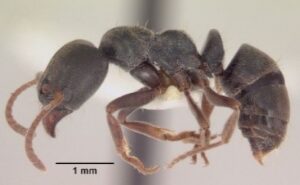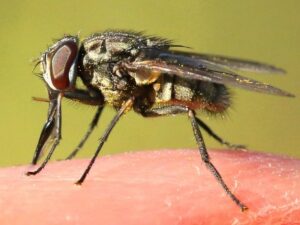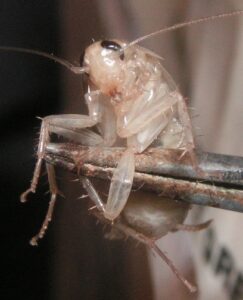Brown Dog Tick:
General Description
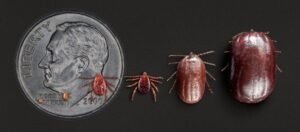
- Eggs of the brown dog tick are spherical and dark brown in color.
- Larvae have three pairs of legs with a body size of approximately 0.5 mm in length and 0.4 mm in width.
- Nymphs and adults have four pairs of legs and look similar except nymphs are smaller than adults.
- Nymphs are 1.15 to 1.30 mm in length and 0.55 to 0.65 mm in width
- Adults are 2.25 to 3.20 mm in length and 1.1 to 1.7 mm in width.
- Nymphs and adults are reddish-brown in color with an elongated body shape and do not have markings on the back.
- Female ticks increase their body size a hundred-fold during feeding, reaching the size of a raisin.
Life Cycle and Common Characteristics
- Brown dog tick is a three-host tick (see life cycle). Three different hosts are required to complete its life cycle, and each stage (larva, nymph, or adult tick) takes one blood meal that takes several days and then falls to the soil, where it molts into the next stage.
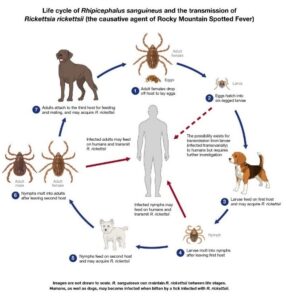
CDC
- The fertilized blood-drinking females leave the host and fall to the ground to lay eggs in cracks in the floors, under breeding and birthing boxes, or in the passages used by domestic animals.
- One female lays 1400-5000 eggs within 9-15 days and then dies.
- The eggs hatch after 15-75 days into larvae that climb the bottom of the walls or furniture and wait for the host to come into contact with it (it may be of the same type as the first host or another type), and they cling to it to suck blood and then leave the host after about 4 days to fall to the ground or cling to the furniture or the walls where they molt and turn into nymphs. These nymphs re-attach to another host that feeds on blood for a period of 3-11 days and then falls to the ground to molt into the adult stage that relates to another host whose blood they feed on for a period of 1-3 weeks, during which the females are fertilized and then leave the host to lay eggs.
- Fertilized larvae and females can wait for the host without feeding for up to 250 days. As for the nymphs, they cannot stay for more than three months.
Damage and Medical Implications
- The brown dog tick parasitizes all types of vertebrate animals, as well as humans and birds.
- The infection of this type is concentrated in the head or the nape and ears and causes severe pain, weakness, and emaciation when infected with dogs and cats.
- High infestation levels can cause skin irritation in dogs.
- The brown dog tick is a vector of several pathogens causing dog diseases including canine ehrlichiosis (Ehrlichia canis) and canine babesiosis (Babesia canis). These rarely cause disease in humans; only a few cases are known.
- In dogs, symptoms of canine ehrlichiosis include lameness, depression, weight loss, anorexia, and fever; for babesiosis symptoms include fever, anorexia, and anemia.
- Rocky Mountain spotted fever, caused by Rickettsia rickettsii, is a severe tick-borne disease in humans. This pathogen was reported to be transmitted by brown dog ticks.


